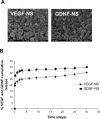Increased antiparkinson efficacy of the combined administration of VEGF- and GDNF-loaded nanospheres in a partial lesion model of Parkinson's disease
- PMID: 24920904
- PMCID: PMC4043720
- DOI: 10.2147/IJN.S61940
Increased antiparkinson efficacy of the combined administration of VEGF- and GDNF-loaded nanospheres in a partial lesion model of Parkinson's disease
Abstract
Current research efforts are focused on the application of growth factors, such as glial cell line-derived neurotrophic factor (GDNF) and vascular endothelial growth factor (VEGF), as neuroregenerative approaches that will prevent the neurodegenerative process in Parkinson's disease. Continuing a previous work published by our research group, and with the aim to overcome different limitations related to growth factor administration, VEGF and GDNF were encapsulated in poly(lactic-co-glycolic acid) nanospheres (NS). This strategy facilitates the combined administration of the VEGF and GDNF into the brain of 6-hydroxydopamine (6-OHDA) partially lesioned rats, resulting in a continuous and simultaneous drug release. The NS particle size was about 200 nm and the simultaneous addition of VEGF NS and GDNF NS resulted in significant protection of the PC-12 cell line against 6-OHDA in vitro. Once the poly(lactic-co-glycolic acid) NS were implanted into the striatum of 6-OHDA partially lesioned rats, the amphetamine rotation behavior test was carried out over 10 weeks, in order to check for in vivo efficacy. The results showed that VEGF NS and GDNF NS significantly decreased the number of amphetamine-induced rotations at the end of the study. In addition, tyrosine hydroxylase immunohistochemical analysis in the striatum and the external substantia nigra confirmed a significant enhancement of neurons in the VEGF NS and GDNF NS treatment group. The synergistic effect of VEGF NS and GDNF NS allows for a reduction of the dose by half, and may be a valuable neurogenerative/neuroreparative approach for treating Parkinson's disease.
Keywords: 6-OHDA; PLGA; nanoparticles; neuroregeneration; neurotrophic factors; tyrosine hydroxylase.
Figures






Similar articles
-
Comparative study of the neurotrophic effects elicited by VEGF-B and GDNF in preclinical in vivo models of Parkinson's disease.Neuroscience. 2014 Jan 31;258:385-400. doi: 10.1016/j.neuroscience.2013.11.038. Epub 2013 Nov 27. Neuroscience. 2014. PMID: 24291725 Free PMC article.
-
In vivo administration of VEGF- and GDNF-releasing biodegradable polymeric microspheres in a severe lesion model of Parkinson's disease.Eur J Pharm Biopharm. 2013 Nov;85(3 Pt B):1183-90. doi: 10.1016/j.ejpb.2013.03.034. Epub 2013 Apr 30. Eur J Pharm Biopharm. 2013. PMID: 23639739
-
Neurotrophic and neuroprotective efficacy of intranasal GDNF in a rat model of Parkinson's disease.Neuroscience. 2014 Aug 22;274:11-23. doi: 10.1016/j.neuroscience.2014.05.019. Epub 2014 May 17. Neuroscience. 2014. PMID: 24845869
-
Encapsulated cell biodelivery of GDNF: a novel clinical strategy for neuroprotection and neuroregeneration in Parkinson's disease?Exp Neurol. 2008 Jan;209(1):82-8. doi: 10.1016/j.expneurol.2007.08.019. Epub 2007 Sep 14. Exp Neurol. 2008. PMID: 17963752 Review.
-
GDNF delivery for Parkinson's disease.Acta Neurochir Suppl. 2007;97(Pt 2):135-54. doi: 10.1007/978-3-211-33081-4_16. Acta Neurochir Suppl. 2007. PMID: 17691299 Review.
Cited by
-
Superparamagnetic iron oxide-gold nanoparticles conjugated with porous coordination cages: Towards controlled drug release for non-invasive neuroregeneration.Nanomedicine. 2021 Jul;35:102392. doi: 10.1016/j.nano.2021.102392. Epub 2021 Apr 16. Nanomedicine. 2021. PMID: 33872772 Free PMC article.
-
VEGFA Isoforms as Pro-Angiogenic Therapeutics for Cerebrovascular Diseases.Biomolecules. 2023 Apr 20;13(4):702. doi: 10.3390/biom13040702. Biomolecules. 2023. PMID: 37189449 Free PMC article. Review.
-
Nanotechnology Approaches for Prevention and Treatment of Chemotherapy-Induced Neurotoxicity, Neuropathy, and Cardiomyopathy in Breast and Ovarian Cancer Survivors.Small. 2024 Oct;20(41):e2300744. doi: 10.1002/smll.202300744. Epub 2023 Apr 14. Small. 2024. PMID: 37058079 Review.
-
Vascular endothelial growth factor: a neurovascular target in neurological diseases.Nat Rev Neurol. 2016 Aug;12(8):439-54. doi: 10.1038/nrneurol.2016.88. Epub 2016 Jul 1. Nat Rev Neurol. 2016. PMID: 27364743 Review.
-
Outside in: Unraveling the Role of Neuroinflammation in the Progression of Parkinson's Disease.Front Neurol. 2018 Oct 15;9:860. doi: 10.3389/fneur.2018.00860. eCollection 2018. Front Neurol. 2018. PMID: 30459700 Free PMC article. Review.
References
-
- Linazasoro G. A global view of Parkinson’s disease pathogenesis: implications for natural history and neuroprotection. Parkinsonism Relat Disord. 2009;15(6):401–405. - PubMed
-
- Obeso JA, Rodriguez-Oroz MC, Goetz CG, et al. Missing pieces in the Parkinson’s disease puzzle. Nat Med. 2010;16(6):653–661. - PubMed
-
- Deierborg T, Soulet D, Roybon L, Hall V, Brundin P. Emerging restorative treatments for Parkinson’s disease. Prog Neurobiol. 2008;85(4):407–432. - PubMed
-
- Sullivan AM, Toulouse A. Neurotrophic factors for the treatment of Parkinson’s disease. Cytokine Growth Factor Rev. 2011;22(3):157–165. - PubMed
-
- Ruozi B, Belletti D, Bondioli L, et al. Neurotrophic factors and neurodegenerative diseases: a delivery issue. Int Rev Neurobiol. 2012;102:207–247. - PubMed
Publication types
MeSH terms
Substances
LinkOut - more resources
Full Text Sources
Other Literature Sources
Medical
Miscellaneous

